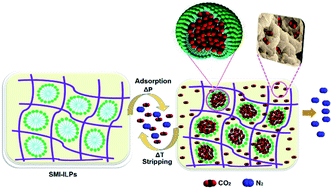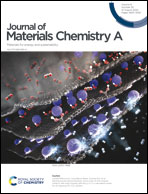Ionic liquid polymer materials with tunable nanopores controlled by surfactant aggregates: a novel approach for CO2 capture†
Abstract
Monomeric ionic liquids (ILs), ionic liquid polymers (ILPs) and IL-based composites have emerged as potential materials for CO2 capture owing to their exceptional intrinsic physical solubility of CO2. This study reports the development of novel IL polymer materials incorporating CO2-philic tunable nanopores and their subsequent utilization for CO2 capture. In this approach, primarily, micelles were formed in monomeric IL 1-vinyl-3-ethylimidazolium bis(trifluoromethylsulfonyl)imide using a CO2-philic surfactant (N-ethyl perfluorooctyl sulfonamide) through self-assembly, from which polymeric materials were fabricated via free radical polymerization. The CO2 adsorption studies demonstrated 3-fold enhancements for the surfactant micelle incorporated IL polymers (SMI-ILPs) compared to their bare IL polymers. The SMI-ILPs were regenerated by simply heating at 70 °C and reused for 15 cycles with a retention of over 96% of CO2 uptake capacity. The simple recovery and notable enhancements in CO2 sorption of novel SMI-ILPs were traced to the adsorption of CO2 at the (i) highly porous IL-based polymeric networks, and (ii) nanometer sized apolar pores made by CO2-philic surfactant tails. This work will open up new possibilities for the development of IL based smart materials for CO2 capture and separation.



 Please wait while we load your content...
Please wait while we load your content...